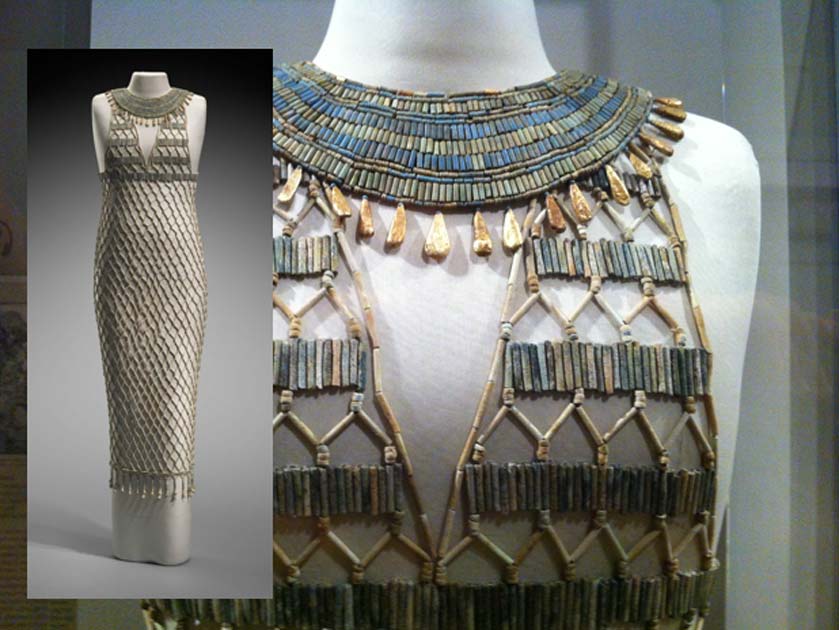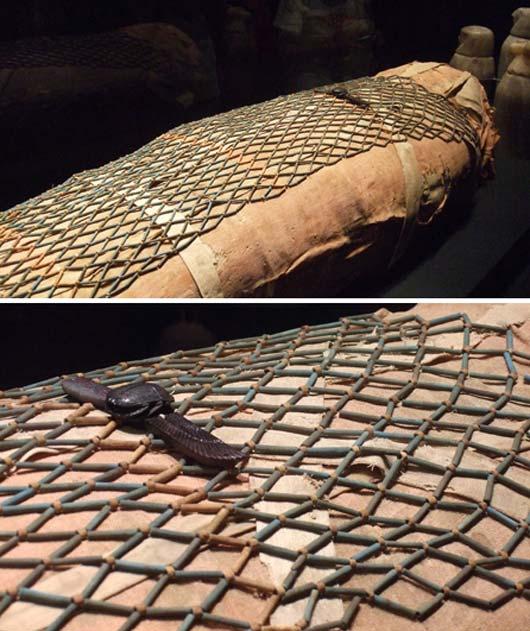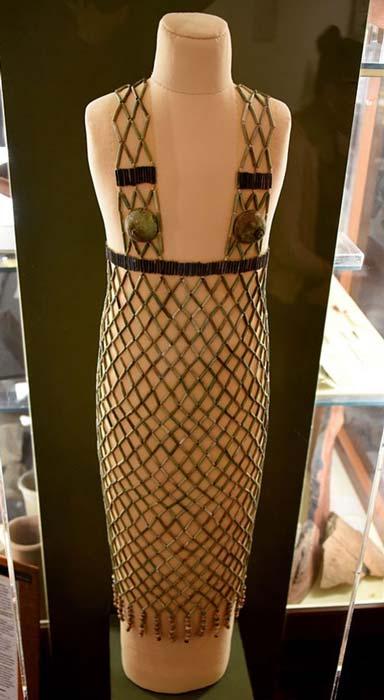In ancient Egypt, one of the most distinctive and fashionable garments was the bead-net dress. This exquisite dress was a testament to the Egyptians’ skill in craftsmanship and their love for elaborate attire.
The bead-net dress was typically made from linen, a common fabric in ancient Egypt. The dress consisted of a fitted, sleeveless bodice that extended down to the ankles. The unique feature of the bead-net dress was the intricate netting of beads that covered the entire garment, creating a shimmering and visually stunning effect.
The beads used in the netting were made from a variety of materials, including faience, glass, semi-precious stones, and metal. These beads were carefully threaded together in intricate patterns, often forming geometric designs or symbolic motifs. The colors of the beads varied, offering a wide range of options for creating vibrant and eye-catching designs.
The bead-net dress was not only a fashion statement but also held symbolic and cultural significance. The elaborate beading patterns often included representations of deities, animals, and other mythological symbols. These symbols were believed to provide protection, luck, and blessings to the wearer.
Bead-net dresses were made with thousands of beads arranged in a lozenge pattern, and although it is believed that women wore such dresses in daily life, most examples have been found in burials. These precious garments are extremely rare, as only 20 of them are known at present. They are kept in various museums around the world.
Articles of clothing made of beads were considered to be a fashion amongst ancient Egyptian women. Priestesses, for instance, wore beaded headdresses and beaded collars. Upper class women also wore nets of faience beads across the middle third of their tunics for festive occasions. For poorer women, they had to be content with a string of beads around their waists. Unlike these bead collars and bead strings, bead-dresses are not so much accessories as they are pieces of clothing in their own right.

A beaded necklace from ancient Egypt, 664-332 BC, faience, carnelian, and limestone beads ( public domain )
It has been suggested that bead-net dresses may have been made in one of two ways. The first is that the beads could have been sewn directly onto a woman’s linen dress as part of this piece of clothing. The second method is that the beads were strung together on a net which was then worn over a linen dress. Some of these dresses, such as the one in the possession of the Museum of Fine Arts, Boston, were made using blue and blue-green faience beads, which were meant to be an imitation of lapis lazuli and turquoise respectively.
The stunning bead-net dress currently on display in the Boston Museum. Photo source: Museum of Fine Arts, Boston .
Bead-net dresses have been found to be depicted on ancient Egyptian reliefs and statues. One example of this is a statue of the sky goddess, Nut, from the 3 rd millennium B.C. This statue depicts the goddess dressed in a piece of clothing that looks very much like a bead-net dress.
In addition, bead-net dresses are also mentioned in a piece of ancient Egyptian literature, i.e. the collection of stories known as the Three Tales of Wonder (known also as the Tales from the Westcar Papyrus ). In one of these stories, known as The Story of the Green Jewel , King Snefru was looking for entertainment in his palace, and he was advised by his chief scribe to go boating on the lake, and have for his rowers the prettiest girls in the king’s harem. In addition, these female rowers, according to one translation, were dressed in nets, presumably the bead-net dresses, instead of normal dresses, for the king’s pleasure.

A m4mmy covered in a bead-net ( Proletariat Fashionista )
As for actual bead-net dresses that have survived till today, these have been mostly found in tombs. For instance, the bead-net dress in the Petrie Museum of Egyptian Archaeology, London is from a 5 th / 6 th Dynasty tomb in Qau, a city in Upper Egypt. This bead-net dress was discovered in 1923/4, and it was initially suggested that the dress might have been worn by a dancer. Around the fringes of this dress were shells plugged with small stones, which made a rattling sound when the wearer moved. Therefore, it was thought that the dress may have been used for erotic dances.

Faience, blue and black cylinder beads, 2 breast caps and 2 strings of Mitra beads. 5th Dynasty. From burial 978 at Qau (Tjebu), Egypt. The Petrie Museum of Egyptian Archaeology, London. ( CC by SA 4.0 )
When this dress was reconstructed, however, it was found that it would have been rather heavy for a dancer to move in it, let alone dance in it. Given that the dress was found in a tomb, it has been speculated that they served a funerary function instead. The bead-net dress in the Petrie Museum is not the only one that was found in a tomb. The own in the Museum of Fine Arts, Boston, for example, was discovered in a tomb in Giza, and dates to the 4 th Dynasty, specifically to the reign of Khufu.
The bead-net dress stands as a testament to the skill and creativity of ancient Egyptian artisans and their ability to transform simple garments into works of art. Its intricate beadwork, symbolism, and association with high social status make it a remarkable example of high fashion in ancient Egypt.






